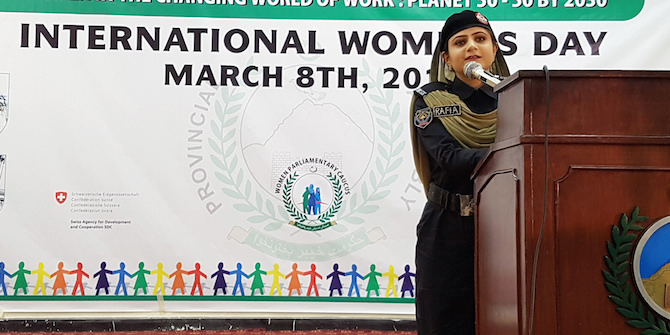 The Surrogacy (Regulation) Bill approved by the Union Cabinet in August 2016 proposes a complete ban on commercial surrogacy and advocates solely its altruistic form. Anjora Sarangi writes there is a dire need to recognise that placing a blanket ban on commercial surrogacy cannot be an overarching solution to the problem of exploitation of women that the practice might result in. She argues that in order to have a significant impact the Bill needs to move away from the philosophical underpinnings of patriarchy that currently guide it.
The Surrogacy (Regulation) Bill approved by the Union Cabinet in August 2016 proposes a complete ban on commercial surrogacy and advocates solely its altruistic form. Anjora Sarangi writes there is a dire need to recognise that placing a blanket ban on commercial surrogacy cannot be an overarching solution to the problem of exploitation of women that the practice might result in. She argues that in order to have a significant impact the Bill needs to move away from the philosophical underpinnings of patriarchy that currently guide it.
In a time when developments in science and technology are far outpacing human evolution, ethical dilemmas crop up with the commercialisation of each new phenomenon. Surrogacy in India has recently emerged as a battleground for fierce debate on gendered ethics, morality, exploitation, rights, regulation and capitalism.
Surrogacy is a method of assisted reproduction in which a woman carries and gives birth to a baby for another person(s) who is/are the intended social parent(s). Surrogate reproduction can either be through a gestational/IVF process wherein the baby has no genetic relation to the surrogate or through the traditional method with natural or artificial impregnation where the baby is genetically related to the surrogate and the male social parent. Surrogacy may be commercial or altruistic (without monetary compensation) in nature. Commercial surrogacy is legal in very few countries such as Ukraine and the Russian Federation. In the US, the states of California and New Hampshire have legalised it, cushioned with regulations.
Commercial surrogacy was introduced to India in 2002 and within a year it spread internationally with several foreign couples coming in to have babies through assisted reproduction at a low cost. It has now flourished to become a £300 million (yearly turnover)-strong industry in India, encouraging reproductive tourism. The fertility market currently boasts of over 200,000 private clinics offering Assisted Reproductive Technology (ART) services without any state interference. Fertility clinics are concentrated in the Southern states of Tamil Nadu, Karnataka and Andhra Pradesh and in the North in Delhi, Punjab and Haryana. Gujarat also has a sizeable number of ART clinics.
Surrogates are paid up to £5000 for a single birth and more if they carry twins. They are also housed at the clinics and provided all medical facilities for the duration of their pregnancy. The Indian Council of Medical Research (ICMR) in 2005 had set guidelines for regulation, accreditation and supervision of surrogacy clinics but without being legally enforceable, they are being observed more in breach than adherence. In the absence of a law governing this space, the practice of commercial surrogacy has been chaotic and confusing with several grey areas.
The debate on commercial surrogacy was sparked off in India with a controversial case in 2008. A Japanese couple commissioned a child through surrogacy in India but during the gestational period the couple got divorced and the baby was rendered stateless, and parentless (as surrogacy is illegal in Japan). Cases of abandonment of babies, exploitation of surrogates and egg donors and non-payment of monetary compensation promised have since increased. The necessity for a law to regulate commercial surrogacy in India has been felt for some time now and in August 2016 the Union Cabinet approved the Surrogacy (Regulation) Bill. However, the provisions of the current version of the Bill are arguably regressive in their approach.
The Bill proposes a complete ban on commercial surrogacy and advocates solely its altruistic form with no monetary compensation except for medical expenses. The implementing and regulatory agencies would be national and state level surrogacy boards. According to the Bill, the surrogate must be a close relative between the ages of 25-35 and can act as a surrogate only once in her lifetime. The intended parents have to be Indian, heterosexual, childless couples who have been married for at least five years (with the woman being in the 23-50 age bracket and the man between 26-55) only if one or both of them have fertility issues. The filters which have been applied to this particular form of reproduction are numerous and almost impossible to satisfy. Further, the Bill by default excludes a sizeable population from availing of surrogacy as a reproductive choice including foreigners, overseas Indians, persons from the LGBT community, live-in couples and single persons.
Adoption, which may be an alternative to surrogacy for having a child has been a complex process beset by delays in the past. However, in recent times, the Ministry of Women and Child Development in India is coordinating and cooperating with other countries to fast-track and streamline the process. It is interesting to note the inconsistency in policies regarding adoption and surrogacy. Time taking procedures for adoption such as producing mandatory separate birth certificates of the child for issuing passports and No Objections Certificates from the Central Adoption Resource Authority (CARA) – the nodal adoption agency for the Indian Government – have recently been lifted. Further, age restrictions for parents looking to adopt are not as strict as those for surrogate parents. Moreover, single persons (both men and women) and Non Resident Indians (NRIs) are allowed to adopt children.
There is dire need to recognise that placing a blanket ban on commercial surrogacy and rigid guidelines for the proposed altruistic surrogacy cannot be an overarching solution to the problem of exploitation of women that the practice of commercial surrogacy might result in. The sector will merely be pushed underground with its inadequate and unsanitary medical conditions, and coercive practices. Further, there is no guarantee that there would be no coercion in the proposed altruistic model of surrogacy. The regressive segments of the Bill such as the exclusion of single persons, live-in and LGBT couples need to be revisited. The patriarchal mores these rely on are also visible in the lower age groups assigned for women social parents compared to their male counterparts. Age guidelines for surrogates too are arbitrary and restrictive. With regard to foreign adoptions, procedures for checking citizenship and rights clauses of the country of origin of the social parents need to be in place. Consent and rights of surrogates along with appropriate monetary compensation also require regulation and protection. The formation of a national agency for regulation, oversight and grievance redress would go a long way in tying up some of the loose ends.
There are three crucial ‘stakeholders’ with regard to surrogacy that need to be protected under the Bill – the surrogate, the intended parents and the surrogate baby. The issues concerning them include the health and wellbeing of the surrogate, her agency over her own body, awareness of the process and consequences of her decision, her consent and rights, citizenship, rights and health of the surrogate baby. Further issues concern control of unethical and potentially dangerous ART procedures, the rights of the intended parents, and regulation and oversight of each level of this process along with monetary exchange. The Bill in its current form fails to address these complexities and nuances and needs to move away from the philosophical underpinnings of patriarchy that guide it, in order to have a significant impact.
Cover image: Newborn (for illustrative purposes only). Credit: Harsha K R CC BY-SA 2.0
This article originally appeared on the LSE Engenderings blog. It gives the views of the author, and not the position of the South Asia @ LSE blog, nor of the London School of Economics. Please read our comments policy before posting.
About the Author
 Anjora Sarangi completed her MSc in Comparative Politics at LSE in 2014. She is interested in issues of gender justice, women and policy, and education. Anjora is a contributor at InPlainspeak, a digital magazine on sexuality in the Global South and has previously interned at a feminist organisation in New Delhi. She currently works as a Public Policy Analyst at the Bharti Institute of Public Policy in the Indian School of Business (ISB).
Anjora Sarangi completed her MSc in Comparative Politics at LSE in 2014. She is interested in issues of gender justice, women and policy, and education. Anjora is a contributor at InPlainspeak, a digital magazine on sexuality in the Global South and has previously interned at a feminist organisation in New Delhi. She currently works as a Public Policy Analyst at the Bharti Institute of Public Policy in the Indian School of Business (ISB).








Very insightful read! Thanks